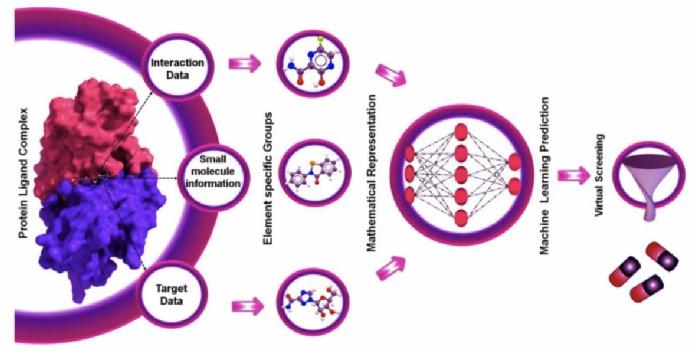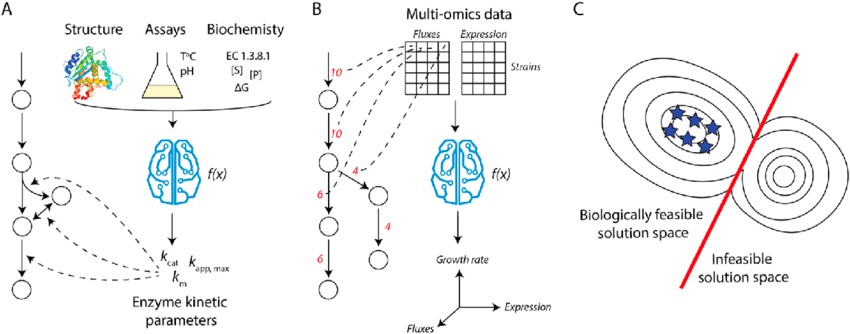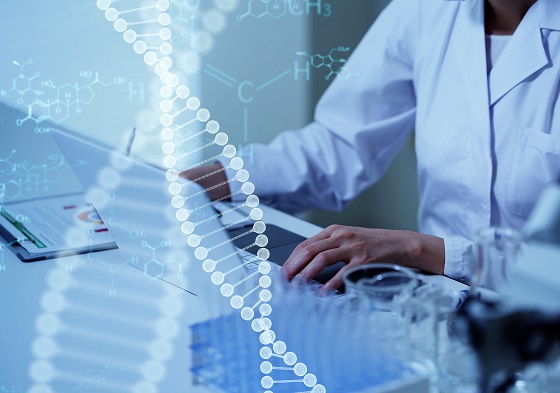The innovative integration of artificial intelligence and machine learning in enzyme design has transformed biotechnology. This method unites AI's exceptional computational power with machine learning's predictive capabilities, enhancing the efficiency and effectiveness of enzyme design. Through studying and utilizing this technique, we can expedite and improve the enzyme design process. This significant advancement impacts a range of fields, such as biotechnology, pharmaceuticals, and beyond.
 Artificial intelligence and machine learning approaches for drug design (Chandrabose S., et al., 2021)
Artificial intelligence and machine learning approaches for drug design (Chandrabose S., et al., 2021)
Technical Route
The adoption of a technical route for the integration of Artificial Intelligence (AI) and machine learning into the design of enzymes involves two centrals, yet intricately interconnected, components. The first of these key components involves the utilization of advanced AI algorithms. These algorithms are expertly designed to analyze the complex makeup of enzymes and predict their respective structures. This is achieved through the dissection of various enzyme properties and characteristics, providing an in-depth understanding of their molecular composition.
The second component of this technical route involves the usage of sophisticated machine learning models. These models are employed with the aim of understanding and, importantly, learning from vast amounts of historical enzyme design data. By processing and analyzing this data, we are able to derive meaningful insights and patterns, which can be used to inform future enzyme design efforts.
The integration of these two cutting-edge technologies brings about a synergistic effect that greatly expedites the enzyme design process, drastically reducing the time taken from ideation to execution. Furthermore, it significantly enhances the accuracy of the design process, minimizing the likelihood of errors and increasing the overall effectiveness of the resulting enzymes.
Service Process
Our process for incorporating AI and machine learning into enzyme design is thorough, detailed, and tailored to our clients' specific requirements. The following is our general service process:
- Initial Consultation: We start with a detailed discussion to fully understand the client's needs, objectives, and specific requirements. This step sets the right expectations and defines the project's scope.
- Project Planning: After initial consultation, we embark on detailed project planning, setting clear timelines, allocating resources, and defining key milestones. A well-structured project plan is key to successful execution.
- Application of AI and Machine Learning Techniques: We then apply AI and machine learning techniques. Our experts use advanced AI algorithms and sophisticated machine learning models to design the enzymes, involving considerable computational work and analysis.
- Enzyme Validation: We validate the designs next, checking their accuracy and efficiency through rigorous testing. This step ensures that the designs are reliable and meet the project's objectives.
- Enzyme Testing: After validation, we conduct comprehensive tests on the enzymes to verify their functionality and efficiency.
- Delivery of Final Enzyme Design: The final step is delivering the enzyme design to the client, ensuring that all project deliverables are met and the client is satisfied with the results.
- Post-Delivery Support: After delivery, we offer continuous support to our clients, always available to answer questions or provide additional assistance.
We place great value on our customers and are always ready to assist. If you have any questions or concerns, please do not hesitate to reach out to us.
Applications
| Application |
Description |
| Drug Discovery |
Utilizes AI and machine learning in enzyme design to expedite the identification of novel drug targets and optimize drug candidates. This approach accelerates the drug discovery process by predicting enzyme-substrate interactions and enhancing drug efficacy. |
| Biocatalysis |
Applies AI and machine learning techniques in enzyme design for the development of efficient biocatalysts. By analyzing enzyme sequences and structures, this approach optimizes enzyme properties for various industrial processes, including pharmaceutical synthesis, biofuel production, and environmental remediation. |
| Protein Engineering |
Integrates AI and machine learning in enzyme design to engineer proteins with tailored properties. This approach enhances protein stability, activity, and specificity for applications in biotechnology, medicine, and biocatalysis. |
| Metabolic Engineering |
Utilizes AI and machine learning to design enzymes for metabolic pathway optimization. By predicting enzyme-substrate interactions, this approach facilitates the production of biofuels, chemicals, and pharmaceuticals through engineered microbial hosts. |
| Enzyme Therapy |
Incorporates AI and machine learning in enzyme design for therapeutic applications. By optimizing enzyme properties such as substrate specificity and immunogenicity, this approach enhances the efficacy and safety of enzyme-based therapies for various diseases. |
| Agricultural Biotechnology |
Applies AI and machine learning in enzyme design for agricultural biotechnology applications. This includes the development of enzymes for crop protection, soil remediation, and plant-microbe interactions, enhancing agricultural sustainability and productivity. |
| Food Industry |
Utilizes AI and machine learning techniques in enzyme design for the food industry. This involves the optimization of enzymes for food processing, flavor enhancement, and nutritional enhancement, improving the efficiency and quality of food production processes. |
Case Study
It is by integrating machine learning and mechanistic models that the benefits of both approaches can be combined: predictability that systematically increases as more data is available, and mechanistic insight. (A) Parametrizing GSMs using machine learning predictions; (B) Using GSMs to derive input features for machine learning; (C) constraining the machine learning solution space with mechanism.
 Integrating machine learning and mechanistic models (Christopher E. Lawson, et al., 2020)
Integrating machine learning and mechanistic models (Christopher E. Lawson, et al., 2020)
FAQs
Here are some frequently asked questions and their answers about the integration of AI and Machine Learning in Enzyme Design. If you don't find the answer you're looking for, feel free to reach out to us.
Q: What are the advantages of employing AI and Machine Learning in Enzyme Design?
A: The use of AI and machine learning in enzyme design has several advantages. The most notable of these is the increase in speed and accuracy of the enzyme design process. This results in a more efficient research and development process, which is invaluable in the fast-paced world of biotechnology.
Q: Is the integration of AI and Machine Learning in Enzyme Design a proven method?
A: Yes, the integration of AI and machine learning in enzyme design is a proven method. It has been successfully applied in numerous enzyme design projects, demonstrating its effectiveness and reliability.
Q: How does AI contribute to the process of enzyme design?
A: AI contributes significantly to the enzyme design process. AI algorithms can predict enzyme structures and behaviors based on existing data, which significantly accelerates the design process. This results in quicker turnaround times for design projects.
Q: How does Machine Learning contribute to the process of enzyme design?
A: Machine learning plays a pivotal role in the enzyme design process. Machine learning models learn from past enzyme design data, improving their predictions over time. This continuous learning process enhances the accuracy of enzyme design.
Q: Which fields stand to benefit from the integration of AI and Machine Learning in Enzyme Design?
A: A wide range of fields can benefit from the integration of AI and Machine Learning in Enzyme Design. These include, but are not limited to, biotechnology, pharmaceuticals, agriculture, and biofuels.
Q: What resources are needed for integrating AI and Machine Learning in Enzyme Design?
A: Implementing AI and machine learning in enzyme design requires resources such as a capable computing infrastructure, access to relevant data for machine learning models, and experts in AI, machine learning, and biotechnology.
Q: How long does the process of integrating AI and Machine Learning in Enzyme Design take?
A: The duration of the process can vary greatly depending on the complexity of the enzyme being designed and the quality of the available data. It could range from weeks to several months.
Q: Are there any limitations or challenges to integrating AI and Machine Learning in Enzyme Design?
A: The integration of AI and machine learning in enzyme design can be challenged by factors such as the availability and quality of data, the complexity of the enzyme structures, and the necessity for interdisciplinary expertise.
Q: Is the approach of using AI and Machine Learning in Enzyme Design cost-effective?
A: Yes, while the initial setup for integrating AI and machine learning can be high, the increased speed and accuracy of enzyme design can lead to significant cost savings in the long run.

































 Artificial intelligence and machine learning approaches for drug design (Chandrabose S., et al., 2021)
Artificial intelligence and machine learning approaches for drug design (Chandrabose S., et al., 2021) Integrating machine learning and mechanistic models (Christopher E. Lawson, et al., 2020)
Integrating machine learning and mechanistic models (Christopher E. Lawson, et al., 2020)